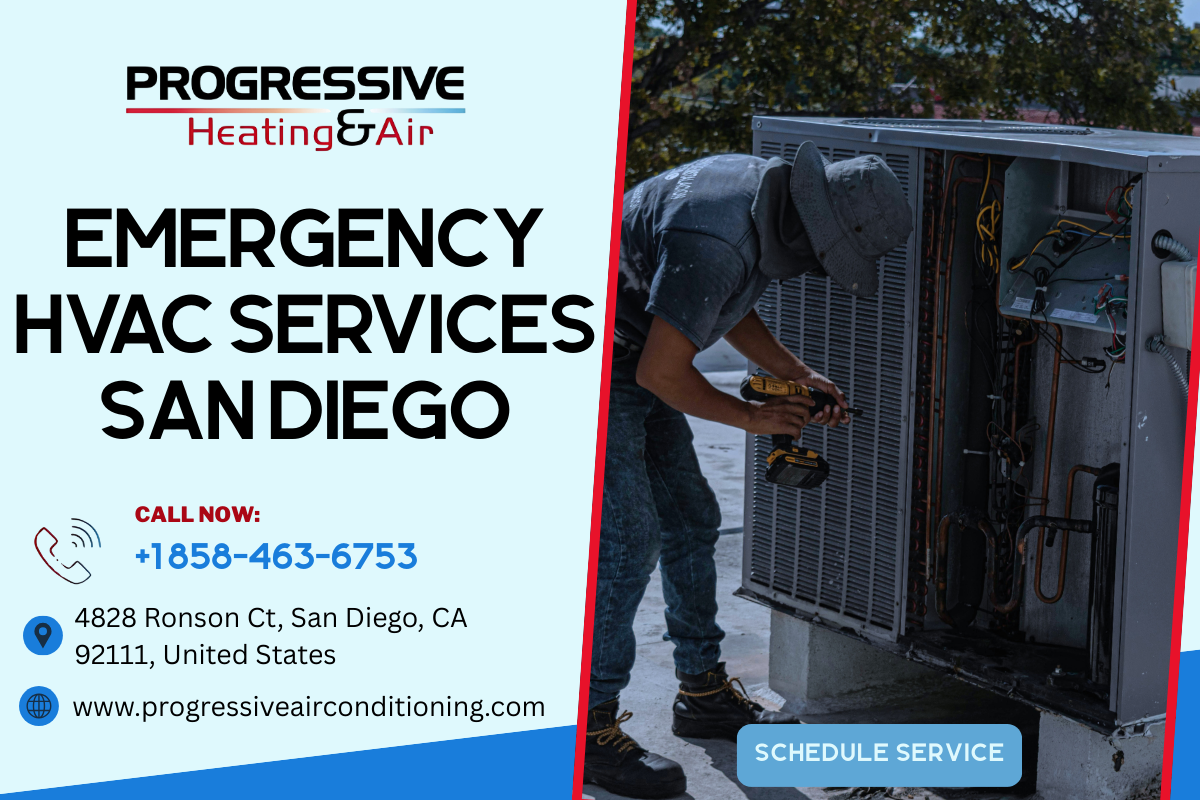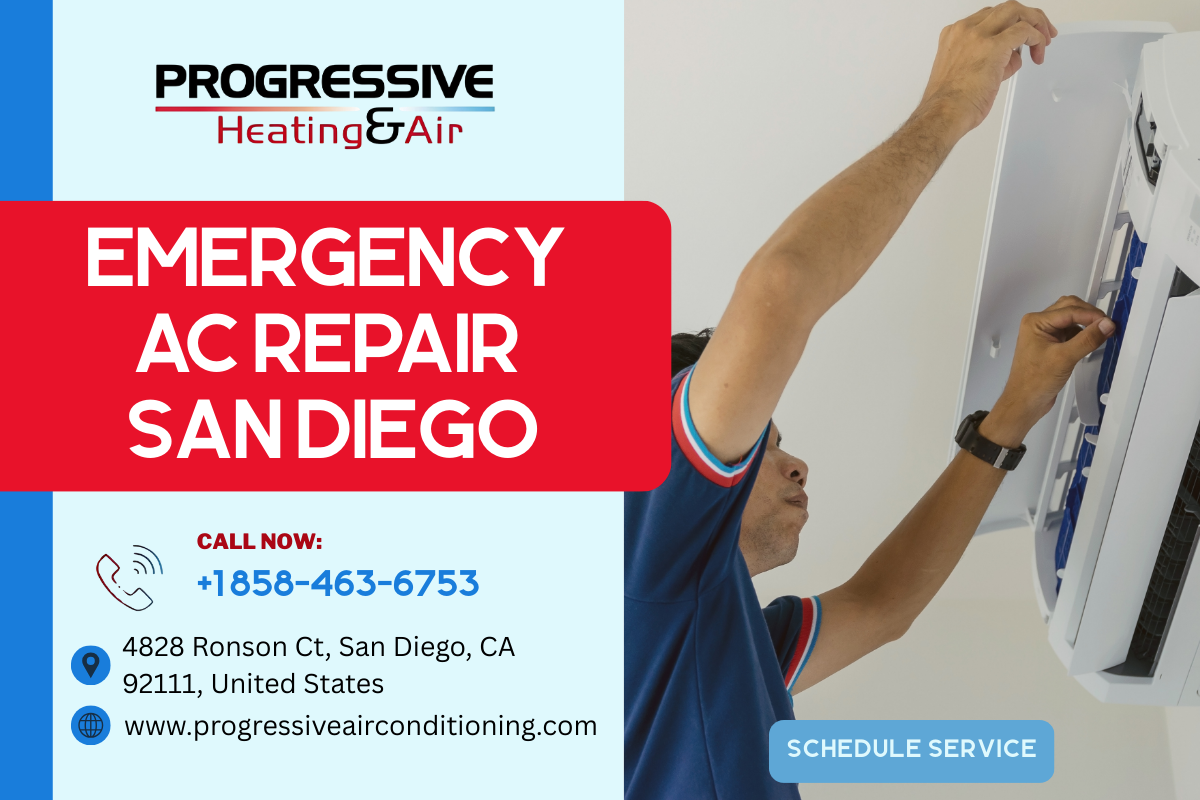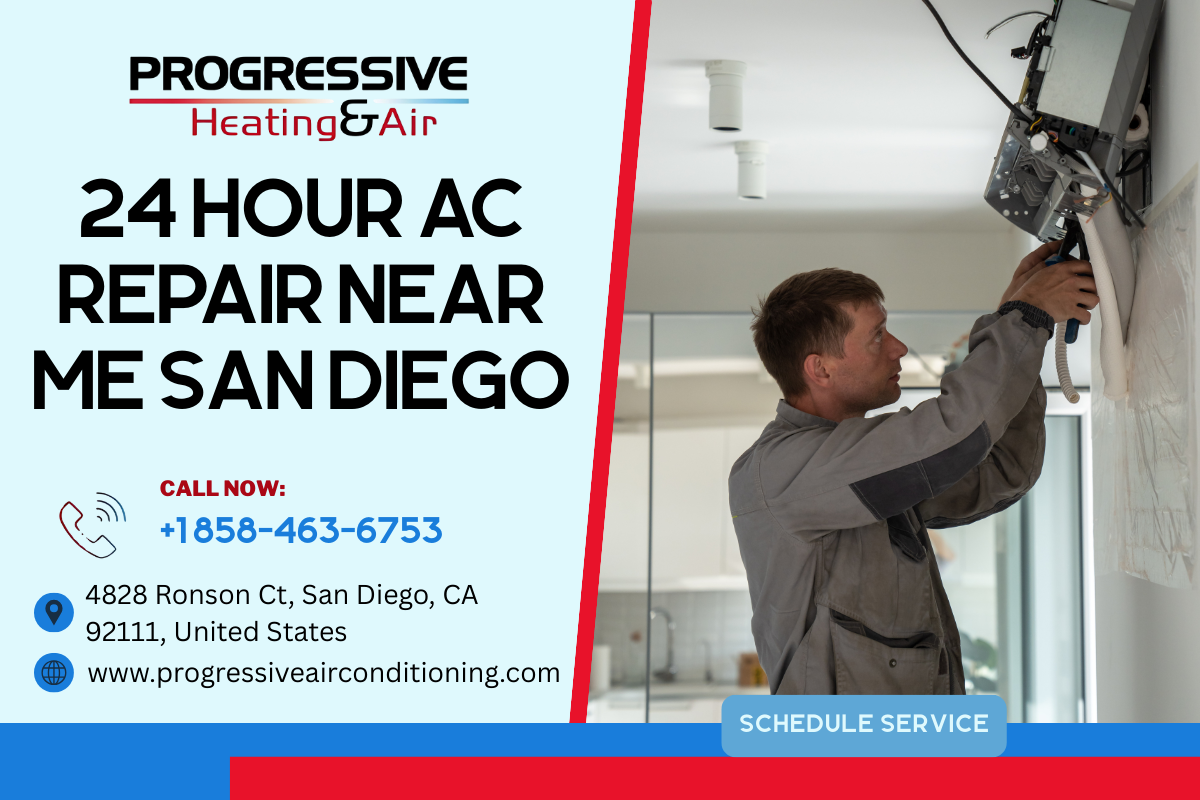


San Diego spoils you with sunsets and sea breezes, but when a hot, still night presses in and your air conditioner gives up, the city’s charm fades fast. The call becomes immediate: who can fix this now, not tomorrow, not “sometime between 8 and 4”? After years of overseeing service crews and crawling through attics from Chula Vista to Carlsbad, I’ve seen the patterns that separate a minor AC scare from a genuine emergency, and the difference between a quick save and an expensive mistake. If you’re searching for 24 hour ac repair near me San Diego, here’s what matters, how to decide what to do first, and how to work with an emergency HVAC company that shows up ready.
When AC trouble is a true emergency
Not every failure needs an overnight dispatch. A thermostat hiccup at 68 degrees on a coastal morning is irritating, not urgent. The rule of thumb: it’s an emergency if safety or property is at risk, or if the delay will be much more expensive than the fix.
High heat and trapped humidity make the stakes real. Interior temperatures climb faster than people expect, especially in newer homes with tight envelopes and big south-facing windows. In late summer, a second-story bedroom can hit 85 to 90 degrees within an hour of compressor failure, and humidity creeps toward 60 percent in homes inland from I-15. If you have infants, elderly family members, or anyone with respiratory issues, that range isn’t just uncomfortable, it’s dangerous. This is when emergency ac repair becomes the right call.
There’s also water to consider. Many San Diego systems use indoor evaporator coils with condensate drains running through attics. A clogged drain or cracked pan can send water into drywall before you notice the ceiling stain. I’ve opened services at 2 a.m. in Scripps Ranch where a ten-minute drain clearing would have saved thousands in repairs. Water plus time equals damage, no matter the zip code.
Electrical smells or tripped breakers carry their own urgency. A burnt odor near the air handler, sparking at the disconnect, or breakers that trip again immediately after resetting suggest a short or a motor winding on its last legs. Calling a 24 hour emergency hvac company here is not overreacting, it’s good judgment.
What a 24-hour service can realistically do at night
A solid emergency hvac repair service San Diego runs trucks that are more like rolling shops. The tech who shows up at 1 a.m. should have capacitors in common sizes, universal contactors, fuses, refrigerant, and basic motors. They can replace a failed capacitor and clean a blocked condensate line on the spot. They can patch a small refrigerant leak long enough to buy you a cool night, then schedule a permanent fix when suppliers open. If the compressor is grounded or the condenser fan motor is seized with an uncommon mount, you might get a temporary workaround: a fan motor with a bracket adapter, or a safe system shutdown to stop repeated breaker trips.
The limitation is parts sourcing. San Diego wholesalers typically close by early evening. On holidays or deep nights, specialty components, proprietary boards, and rare fan motors may be impossible to obtain. That’s where experience shows. The best emergency hvac company San Diego crews carry well-chosen universal parts, know which substitutions are safe, and are honest when a night fix would introduce risk. I’ve advised clients in Rancho Bernardo to let the system rest until morning rather than force a short-cycle restart that could take a compressor from wounded to dead.
How to triage before you call
You can solve some problems in two minutes, no tools, even when tired and sweaty. Do these checks before searching for 24 hour ac repair near me:
- Thermostat basics: Confirm it’s set to Cool, not Fan, with a sensible target temperature. Replace batteries if it has them, and reseat the thermostat on its base to ensure good contact. Breakers and disconnects: Check the main panel for a tripped AC breaker. Fully switch it off, then on. Inspect the outdoor unit’s disconnect box for a pulled or blown fuse if you’re comfortable doing so. Airflow: Confirm the return filter isn’t matted with dust. If you can’t see light through it, replace it. Closed or blocked supply registers, especially in small rooms, can cause coil freeze. Condensate safety switch: Many indoor units have a float switch in the drain line. If the drain is backed up, the switch locks out cooling. Gently remove standing water or clear a visible clog at the trap if accessible. Frozen coil pause: If the indoor coil froze, you’ll see little airflow and sometimes frost on the refrigerant lines near the air handler. Turn the system to Fan only for 30 to 60 minutes to thaw, then try cooling again.
Those steps solve about 10 to 20 percent of “emergencies” on their own. If the system still won’t cool, or if there are electrical smells or water leaks, make the call.
The San Diego specifics: climate, homes, and seasons
Microclimates matter. Along the coast, temperatures usually drop at night, and that means you may have a window to ventilate and delay service until morning without hardship. East of the 805, especially in El Cajon, Escondido, and parts of Poway and La Mesa, night heat can linger. Roof-mounted package units, common in commercial spaces and some older homes, bake in the sun all afternoon and can carry that heat well into the evening. Systems run harder and fail more often after heatwaves and Santa Ana winds, when dust and low humidity strain capacitors and fan motors.
Newer infill properties, with tight building envelopes and smaller mechanical closets, depend heavily on clean filters and unobstructed returns. I once serviced a Mission Valley townhome where a decorative bench blocked the only return grille. The coil froze solid in under an hour during a dinner party with six guests. A simple repositioning prevented repeated night calls.
Coastal corrosion is another local factor. Outdoor condenser units within a mile of the ocean age faster, especially if they’re not rinsed a few times each year. I’ve replaced contactors in Pacific Beach that were so pitted from salt air they looked sandblasted after just three years. If you live close to the water, a 24 hour ac repair near me San Diego search should include companies that mention coastal maintenance and have parts ready for corrosion-prone models.
What you can expect to pay for emergency service
Night and holiday calls cost more, and reputable firms are transparent about it. In San Diego, emergency diagnostic fees commonly run 150 to 250 after hours, sometimes higher on major holidays. Parts and labor add to that. A capacitor swap might end up in the 200 to 400 range all-in, depending on accessibility and markup policies. Clearing a condensate line may be similar if it needs a full flush and safety switch test. Refrigerant work varies widely because pricing depends on type, amount, and leak diagnostics. Expect a range rather than a precise number over the phone. If a company quotes a too-good-to-be-true flat fee for any repair, tread carefully.
Good dispatchers will explain the night differential clearly and offer alternatives if the situation allows. I advise homeowners to ask for a cooling strategy rather than a part name. For example: “Can you get me cooling tonight with a safe temporary fix, then complete the permanent repair tomorrow?” The answer and the confidence behind it tell you a lot about the technician’s readiness.
The right way to vet an emergency hvac company under pressure
People default to the first search result. That can work, but a minute of targeted questions saves headaches. You are looking for an emergency hvac company San Diego that answers the phone with an actual dispatcher, not a voicemail funnel, and can provide clear details about what’s on the truck and who is on call.
Ask three targeted questions:
- What common parts does your on-call tech carry tonight? You want to hear capacitors, contactors, fuses, a universal condenser fan motor, refrigerant, and basic controls. Do you provide a written quote before work and a warranty on parts and labor? Reputable outfits will say yes and specify time frames, often 1 year on parts and 90 days to 1 year on labor for standard components. If you can’t complete the permanent repair tonight, do you charge a second diagnostic tomorrow? The better companies credit the initial diagnostic toward the final repair or waive a second fee.
If the dispatcher hedges, you’re not dealing with a strong 24 hour emergency hvac company. San Diego has plenty of operators who answer at night but send understocked trucks. You can avoid that trap with these questions.
Common failure points after hours, and how pros address them
Capacitors top the list. Heat stress and voltage fluctuations during peak demand weaken them. A failing run capacitor gives you the classic symptoms: condenser fan spinning slowly or not at all, loud humming from the unit, and warm air from vents. A tech checks with a multimeter and swaps the part in minutes. I often recommend replacing both the fan and compressor capacitors together if one is failing and both are the same age, to avoid a second call.
Contactors come next. Pitted contacts prevent proper power delivery to the compressor and fan. You may hear clicking without the unit starting. Replacing a contactor is straightforward when the part is standard; coastal homes see this more often because salt accelerates contact wear.
Condensate blockages are the hidden night wrecker. A float switch cuts the system to https://maps.app.goo.gl/RiU5Gpw6PrHhwWQ67 prevent overflow, which is good, but it leaves you without cooling. A well-prepared emergency hvac repair service San Diego will flush the line with nitrogen or a pump, clear the trap, and test the safety. They’ll also check for secondary pans, which can hold water and trigger additional switches.
Frozen evaporator coils can be both cause and effect. Low airflow from a clogged filter or closed registers often triggers ice buildup. Low refrigerant from a leak can do the same, especially during extended runtimes. The right move is to thaw fully, then test static pressure, blower speed, and refrigerant charge. Band-aids at night here might include opening registers, replacing filters, and making a gentle charge adjustment to keep you cool with a promise to return for leak detection.
Finally, blower motors fail more often than people think. In attics and tight closets, heat shortens their life. Universal ECM replacements exist but can be tricky in the dark. A skilled tech may lubricate and nudge a failing PSC motor to keep it running through the night and return with the exact OEM or approved replacement first thing in the morning. That decision depends on the motor’s condition and safety.
The pros and cons of same day air conditioner repair
Speed has value, but so does thoroughness. Same day air conditioner repair is worth the rush fee when interior temps are soaring, when water is present, or when a simple fix is highly likely. In many cases, same-day service avoids more costly damage, like drywall repairs from condensate overflow or a compressor failure caused by repeated hard starts.
On the other hand, system replacements, major duct modifications, or complex control board issues benefit from daylight and full parts access. I’ve paused jobs in Mira Mesa at 11 p.m. because the only safe board was a supplier item. We kept the home livable with fans, advised window ventilation given the cooler coastal night, and returned at 8 a.m. to finish. The total cost was lower, the work cleaner, and the risk minimal.
The balance is context. If you’re inland during a heatwave, or the system cools bedrooms for vulnerable residents, prioritize speed. If you’re coastal with a nighttime breeze and the problem is clearly a specialty component, consider a morning push.
Working with HOAs, property managers, and tenants
San Diego’s condos and managed properties introduce a layer of approvals and access challenges. I’ve had emergency calls stall because the roof hatch was locked or the HOA required prior notice. If you’re a tenant, call the property manager first, but also protect yourself by documenting temperatures and any water leaks with timestamps and photos. Most professional managers will authorize an emergency hvac company once they see 85-plus degree interiors or water intrusion.
For condo owners with shared roofs, confirm that the contractor has the necessary insurance and that the HOA’s after-hours procedures allow access. Good emergency ac repair San Diego outfits are used to this dance and carry the documentation that gets security to open doors at odd hours.
How to help your tech help you
Details shrink diagnosis time. Share the system’s age if you know it, the model brand, and any recent service. Describe the symptom sequence: was there humming before silence, did it trip the breaker, did you see frost, did water collect in the closet? Even simple notes like “outdoor fan runs but air is warm” or “thermostat went blank, then came back” guide the first checks.
Clear a path to the air handler and electrical panel. Put pets in a separate room. If it’s outside, flip on lights and have a hose ready if the tech needs to rinse the condenser coil. Small courtesies make a 45-minute fix feel like 20.
When repair crosses into replacement territory
Emergency calls sometimes expose bigger truths. A 20-year-old R-22 system that leaks is often better replaced than recharged, especially if the coil or compressor is suspect. In San Diego, typical system lifespans range 12 to 18 years, shorter near the coast, longer inland with good maintenance. When the repair quote pushes 30 to 40 percent of the cost of a new, efficient system, and the unit is already past midlife, replacement is sensible.
A reputable emergency hvac company San Diego won’t pressure you to decide at 2 a.m. They’ll stabilize the situation, provide a frank assessment, and schedule a daytime consultation. If any company tries to leverage the urgency of an after-hours failure to force a same-night replacement decision, find another provider.
The value of preventive maintenance in a city like ours
Most of the emergencies I see are preventable. Twice-yearly maintenance fits our climate, especially for systems that run heavily through early fall. The maintenance list is not glamorous but it works: coil cleaning, capacitor testing under load, contactor inspection, condensate flush, refrigerant check, blower wheel cleaning, and static pressure measurement. The last two often get skipped but can tell you if your ducts or filters are strangling airflow. In neighborhoods with construction dust or near the coast, add a light condenser rinse every two to three months during summer.
It’s also worth installing simple safeguards. A secondary drain pan with a float switch under the air handler costs little and can prevent ceiling collapse. Surge protection on the condenser circuit helps during heatwaves when utility voltage sags. Smart thermostats with humidity display tell you more than a simple set point and help catch problems early.
Matching the service to your need: a simple decision guide
Here’s a concise way to decide your next move when the AC quits, grounded in the realities of San Diego’s housing and weather:
- Safety or damage risk present? Call an emergency hvac repair service San Diego immediately. Signs include interior temps above 85 with vulnerable occupants, water at the air handler, electrical smells, or breakers tripping instantly. Livable conditions and coastal breeze? Ventilate, run fans, and schedule first-thing morning. You’ll likely save on fees and get better parts access. Suspected simple failure like a capacitor or clogged drain and it’s still hot after sunset? A 24 hour ac repair near me call often pays for itself in comfort and prevention. Old system with recurring issues? Use the emergency visit to stabilize, then plan a daytime evaluation. Keep options open until you have a full quote and efficiency comparison.
Final thoughts from the field
San Diego offers plenty of choices for emergency ac repair. The difference is in readiness and honesty. A dependable emergency hvac company shows up at midnight with the parts that fail most, tells you what they can do tonight and what can wait, and backs their work. They respect that sometimes you just need sleep in a cool room, not a lecture on SEER ratings at 3 a.m.
If you’re scanning for emergency hvac company San Diego, look for signs of a true 24 hour operation: real people answering the phone, clear after-hours pricing, trucks stocked for night work, and technicians who can explain a temporary and permanent fix without drama. That’s the service you need when the house is hot, the air is still, and you want your home, not your AC, to be the easiest part of your night.